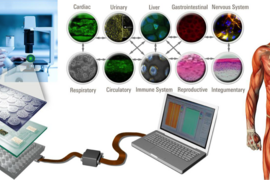A cooperative agreement between MIT and DARPA worth up to $26.3 million will be used to establish a new program titled “Barrier-Immune-Organ: MIcrophysiology, Microenvironment Engineered TIssue Construct Systems” (BIO-MIMETICS) at MIT, in collaboration with researchers at the Charles Stark Draper Laboratory, MatTek Corp. and Zyoxel Ltd. The BIO-MIMETICS proposal was one of two award winners selected as part of the Microphysiological Systems (MPS) program at DARPA, and will be led by MIT professor Linda Griffith in collaboration with MIT professors Steven Tannenbaum, Darrell Irvine, Paula Hammond, Eric Alm and Douglas Lauffenburger. Jeffrey Borenstein and Shankar Sundaram will lead the work at Draper Laboratory, Patrick Hayden will lead the work at MatTek, and David Hughes will lead the work at Zyoxel.
The BIO-MIMETICS program will combine technologies developed at MIT, Draper Laboratory, MatTek and Zyoxel to create a versatile microfluidic platform that can incorporate up to 10 individual engineered human microphysiological organ system modules in an interacting circuit. The modules will be designed to mimic the functions of specific organ systems representing a broad spectrum of human tissues, including the circulatory, endocrine, gastrointestinal, immune, integumentary, musculoskeletal, nervous, reproductive, respiratory and urinary systems. The goal of the program is to create a versatile platform capable of accurately predicting drug and vaccine efficacy, toxicity, and pharmacokinetics in preclinical testing. The BIO-MIMETICS team anticipates that the platform will be suitable for use in regulatory review, amenable to rapid translation to the biopharmaceutical research community, and adaptable for integration of future technologies (such as advances in stem cell technologies and personalized medicine).
A cooperative agreement worth up to $6.25 million from the National Center for Advancing Translational Sciences (NCATS) at NIH will support a complementary research initiative at MIT and Draper Laboratory, in collaboration with professors Alan Wells, Donna Stolz and Raman Venkataramanan at the University of Pittsburgh. The aim of this project is to model cancer metastasis therapies using engineered human tissue constructs, with a goal of adapting this work to the integrated BIO-MIMETICS platform.






